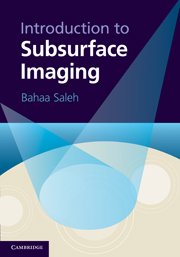Book contents
- Frontmatter
- Contents
- Authors and Contributors
- Preface
- Acknowledgements
- Outline and Roadmap
- 1 Overview
- 2 Physical Models
- 3 Localized Imaging
- 4 Tomographic Imaging
- 5 Digital Image Processing
- 6 Spectral Imaging
- 7 Mosaicing, Change Detection, and Multisensor Imaging
- 8 Numerical Simulation
- 9 Design of Subsurface Imaging Systems
- A Multi-Dimensional Signals and Systems
- B Linear Algebra
- C Detection and Classification
- D Software Tools
- Index
9 - Design of Subsurface Imaging Systems
Published online by Cambridge University Press: 05 June 2012
- Frontmatter
- Contents
- Authors and Contributors
- Preface
- Acknowledgements
- Outline and Roadmap
- 1 Overview
- 2 Physical Models
- 3 Localized Imaging
- 4 Tomographic Imaging
- 5 Digital Image Processing
- 6 Spectral Imaging
- 7 Mosaicing, Change Detection, and Multisensor Imaging
- 8 Numerical Simulation
- 9 Design of Subsurface Imaging Systems
- A Multi-Dimensional Signals and Systems
- B Linear Algebra
- C Detection and Classification
- D Software Tools
- Index
Summary
The basic concepts and methods of subsurface imaging were introduced in previous chapters, starting with the acquisition of information by use of localized or tomographic probes (Chapters 3 and 4) of single or multiple wavelengths (Chapter 6), and including inversion methods for estimating (mapping) the spatial distribution of the sensed parameter(s) (Chapter 5). Applications other than mapping included image classification (Chapter 6), and change detection (Chapter 7).
In this chapter, we revisit these topics with the goal of developing a set of guidelines for systematically designing subsurface imaging systems suitable for any new application. The optimization involved in the design process naturally depends on the ultimate goal, be it imagery, target detection, or object classification. Some common attributes are, of course, applicable to all of these different tasks. For example, the ability to resolve details of an object's shape and structure, which is necessary for good imagery, may also be useful for target detection, since it helps discriminate the target from the surrounding clutter. In other situations, however, high spatial resolution may be unnecessary, or even undesirable, for target detection if the target is recognized totally on the basis of a spectral signature that is distinguishable from the clutter's. The end result of this process is a working system for the task at hand.
Two case studies of subsurface detection problems are presented in some detail as examples of the use of these general guidelines: humanitarian demining and breast cancer detection.
- Type
- Chapter
- Information
- Introduction to Subsurface Imaging , pp. 361 - 387Publisher: Cambridge University PressPrint publication year: 2011



